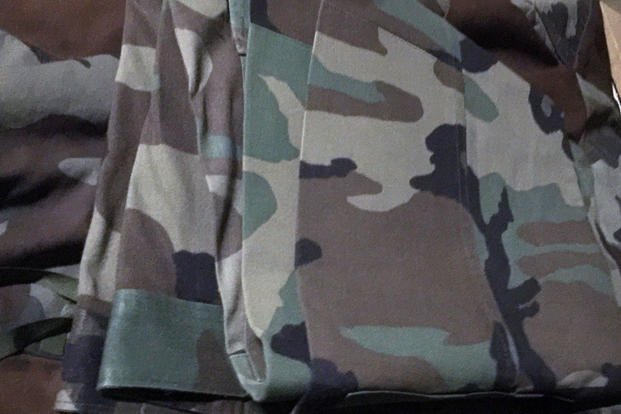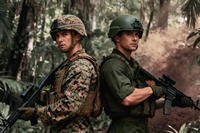When you think of "camouflage," there's a good chance the first image that comes to mind is the woodland pattern on the Battle Dress Uniform.
From 1981 until the early 2000s, this was the one uniform that firmly identified a member of the U.S. military. It didn't matter in which branch they served, that woodland camouflage commanded respect. All of the most famous advertisements for joining the armed forces featured this uniform.
Despite being in service for so long, the uniform went mostly unchanged for 20-plus years. The Pentagon eventually issued summer-weight versions; the button waist adjusters gave way to an easier sliding tab; and the lapels on the BDU blouse were shortened.

It seemed like the perfect working uniform -- until commanders started demanding improvements. They began with demanding trouser-like creases in the pant legs. Then came creases in the arm sleeve. These all eventually became regulations. American troops then did what they do best: trying to outdo one another in the quest to look as "sharp" as possible.
By the end of its time in service, between 2005 and 2012, depending on the service branch, the BDU had suffered a stream of adjustments that would either make troops' lives easier or so much harder, depending on what they tried.
These adjustments were by no means universal, but they happened. A lot. We got a little carried away.
5. Intense Levels of Starch
Two sets of my BDUs were the same ones issued to me in basic training, a stunning tribute to the durability of the uniform. When preparing them for an inspection day or some other event where people would care how sharp my creases were, I unloaded an entire can of starch into them.
Twelve years later, these uniforms are still so crisp, they literally stand up on their own. If anyone took their BDUs to the base laundry or an on-base dry cleaner, they would likely receive the same treatment.
There were entire businesses dedicated to this practice, right outside most gates.
You can't get "laser creases" into this nylon-cotton blend without the use of performance-enhancing substances. After treating them with starch, they needed only a simple iron now and then to renew the creases, which kept my effort minimal, along with my washes.

I wasn't going to "break starch" (put on a new uniform) for no reason. And when I touched up, my BDUs glowed with the flash that only superheated starch on cotton BDUs could bring.
4. Sewing Creases into Arms and Legs
Maybe you needed laser creases but didn't want to put the effort into your everyday wear. Maybe you wanted to avoid "summer creases" (summer here, summer there, creases everywhere). Either way, starch wasn't your thing.
The simple solution was to go to that same off-base dry cleaner and see whether they had an alterations service to put a seam right where the regulations said that crease should be. They usually did.
Because, again, they were near the base for a reason. And they knew every word of whatever regulation governed your branch's uniform wear.
Some airmen would put plastic fishing line in the crease of their BDU sleeves and iron over it to melt the line into the crease, creating an instant, permanent crease.
Either way, you could easily walk into work every day, looking like you at least tried to touch up those creases, even if you just rolled out of bed.
3. Gluing Down Pocket Flaps
With BDUs, it wasn't only hands that didn't belong in your pockets. Using any of the pockets on the BDU blouse was a faux pas that would cause any onlooking officer to metaphorically clutch their pearls.
While it was perfectly acceptable to use the waist pockets on the BDU pants (for any purpose except keeping your hands warm), using the side leg pockets would cause equal amounts of confusion and alarm, as they poofed out with use.
The solution American troops found to this issue was to literally glue or sew those pockets flaps shut and either sew the inner pockets down or remove them entirely. You can't use pockets you don't actually have.
If you needed those pockets for combat, you probably weren't deploying with that uniform anyway.
2. Using Weights Inside Pant Legs
Not only did those pants need to be creased and clean, if you were going to take them to the next level, they needed to be straight-legged too.
There's no better way to keep pants looking like they've never been worn even when you're currently wearing them than installing heavy rubber weights in the area you also just bloused.
Grown adults would blouse their BDU pants as usual, but instead of allowing the material to naturally flow over the tops of their expertly-shined combat boots, they would control how they looked -- by force.
Very large, very heavy rubber cuffs were placed at the bottom of the bloused pant area so the wearer could smooth the fabric flowing over his or her boots over and around the heavy rubber cuff.
The end result made it look like the wearers' pants weren't bloused work pants, but instead were doggedly-starched camouflage pattern dress pants.
1. Cutting Off Sleeves
It gets super hot in many of the places American troops are based or deployed. In those instances, BDU-wearing soldiers, airmen, sailors and Marines would be allowed to roll their sleeves to a predetermined area on their arm.
The Navy and Marine Corps wore their rolled BDU sleeves with the lighter-colored material facing out, while the Army and Air Force wore rolled sleeved mostly rolled this way, but with the outer cuff facing outwardly.
As if anyone else wore rolled sleeves like that anywhere, ever.

If stationed somewhere that gets continually hot and required rolled sleeves day-after-day, some airmen and soldiers would simplify the rolling process. Normally, they would have to keep the roll perfectly flat and get the outer cuff on top, then have to restarch and iron the sleeves once they came down.
Or they could just cut off most of the sleeve and sew the cuff to the predetermined place on the short sleeve, to make a perfect short-sleeved BDU blouse, one they'd have to change immediately if a VIP showed up.
No problem, though. A regular pressed, heavy-starched replacement was probably somewhere close at hand.
-- Blake Stilwell can be reached at blake.stilwell@military.com.
Want to Learn More About Military Life?
Whether you're thinking of joining the military, looking for post-military careers or keeping up with military life and benefits, Military.com has you covered. Subscribe to Military.com to have military news, updates and resources delivered directly to your inbox.
















